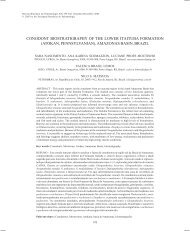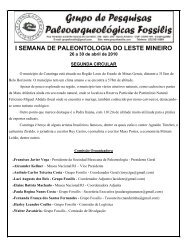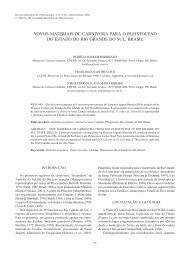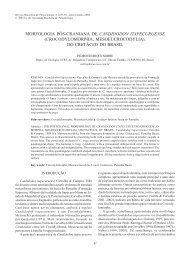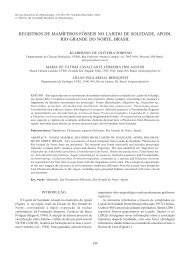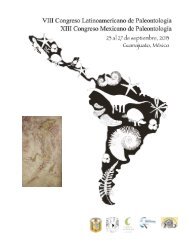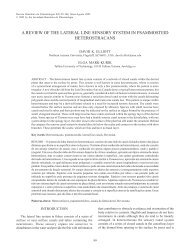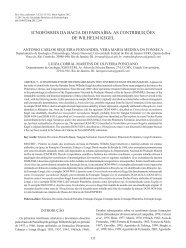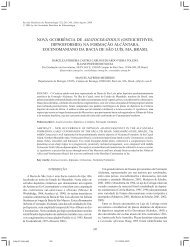new postcranial remains of smilodon populator lund, 1842
new postcranial remains of smilodon populator lund, 1842
new postcranial remains of smilodon populator lund, 1842
Create successful ePaper yourself
Turn your PDF publications into a flip-book with our unique Google optimized e-Paper software.
204<br />
REVISTA BRASILEIRA DE PALEONTOLOGIA,11(3), 2008<br />
Figura 5. Smilodon <strong>populator</strong> from Abismo Iguatemi. A-C, MZSP-PV06, right astragalus in proximal (A), distal (B), and caudal (C) views.<br />
Abbreviations: af, astragalar foramen; an, articulation for the navicular; au, auxiliar foramina; dp, distoplantar projection; fc, medial facet<br />
for calcaneus; fc’, lateral facet for calcaneus; ff, articulation for the fibula; lg, longitudinal groove; pf, proximal foramen. Scale bar = 20 mm.<br />
medial to which a scar for the m. vastus intermedius is seen.<br />
The inner tibial articulation is slightly larger than the outer,<br />
and both are separated by a narrow intercondylar notch.<br />
Directly proximal to the tibial condyles, the caudal surface <strong>of</strong><br />
the femur bears prominent rugose areas for the origins <strong>of</strong> m.<br />
gastrocnemius.<br />
Astragalus<br />
The right astragalus (MZSP-PV 06) is a “short-necked”<br />
astragalus sensu Merriam & Stock (1932). It lacks the proximal<br />
margin <strong>of</strong> the trochlea, most <strong>of</strong> the articulation for the<br />
navicular, and the distal facet for the calcaneus (Figure 5).<br />
The articular surface for the fibula is broad and slightly<br />
concave. A deep longitudinal groove separates the lateral<br />
facet from the medial facet for the calcaneus, which is rounded<br />
and has a disto-plantar projection. Differently from those<br />
described by Merriam & Stock (1932) and Rodrigues et al.<br />
(2004), MZSP-PV 06 has a 3.5 mm astragalar foramen, a 4 mm<br />
foramen at the proximal surface, and several smaller auxiliary<br />
foramina scattered on the plantar surface, as well as<br />
surrounding the astragalar foramen.<br />
COMMENTS ON THE SABER-TOOTHED CAT<br />
OF ABISMO IGUATEMI<br />
Given that the specimens share equivalent size, similar<br />
preservation, and were found relatively close to one another<br />
without duplicated elements, it is suggested that these belong<br />
to a single individual. The animal might have entered the<br />
fissure partially or completely articulated, either trapped or<br />
dragged by pluvial flood as a carcass. Considering the nature<br />
<strong>of</strong> the deposits and the relief <strong>of</strong> Abismo Iguatemi, the<br />
fragmentation and weathering <strong>of</strong> the fossils seem related to<br />
reworking inside the cave.<br />
The dimensions <strong>of</strong> the studied material are on average<br />
greater than those measured by Merriam & Stock (1932) on<br />
North American Smilodon, but approach those <strong>of</strong> other South<br />
American specimens (Burmeister, 1866; Churcher, 1967;<br />
Cartelle & Abuhid, 1989; Méndez-Alzola, 1941). The radius<br />
MZSP-PV 04 is subequal in length to that described by<br />
Burmeister (1866), but shorter than those measured by Kurtén<br />
& Werdelin (1990) and Méndez-Alzola (1941). It is also broader<br />
at the mid-shaft than the radius described by Cartelle &<br />
Abuhid (1989), as well as larger and more robust than the<br />
average measured by Meriam & Stock (1932; Table 1).<br />
Similarly, the acetabulum diameter “measured at right angles<br />
to long axis <strong>of</strong> internal notch” <strong>of</strong> MZSP-PV 02 (= 53.5 mm) is<br />
PROVAS<br />
Table 1. Measurements (mm) <strong>of</strong> Smilodon <strong>populator</strong> radia<br />
compared with the data from Merriam & Stock (1932).<br />
Abbreviations: A, greatest length; B, cranial-caudal dimension<br />
<strong>of</strong> the shaft at middle; C, lateral-medial dimension <strong>of</strong> the shaft at<br />
middle; D, greatest cranial-caudal dimension <strong>of</strong> the distal end; E,<br />
greatest lateral-medial dimension <strong>of</strong> the distal end; e, estimated<br />
measurement.<br />
MZSP-<br />
PV 04<br />
Average<br />
(maxi-min)<br />
A 270e 265.7 (295-235)<br />
B 23 20.7 (24.6-16.5)<br />
C 35 31.9 (38.8-26.0)<br />
D 50 42.9 (48.2-35.6)<br />
E 75 58.0 (67.3-49.4)<br />
B/A x 10 0.85 0.78 (0.83-0.70)<br />
C/A 0.13 0.12 (0.14-0.10)<br />
D/A 0.19 0.16 (0.16-0.15)<br />
E/A 0.28 0.22 (0.23-0.20)



